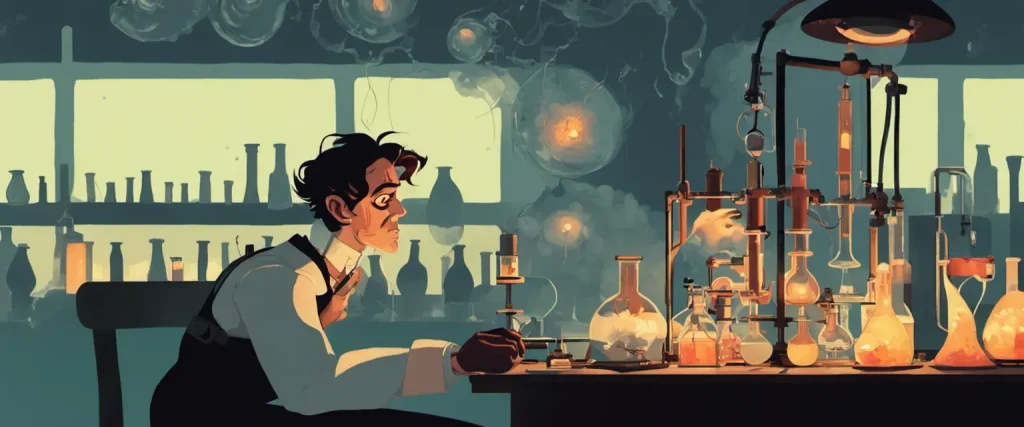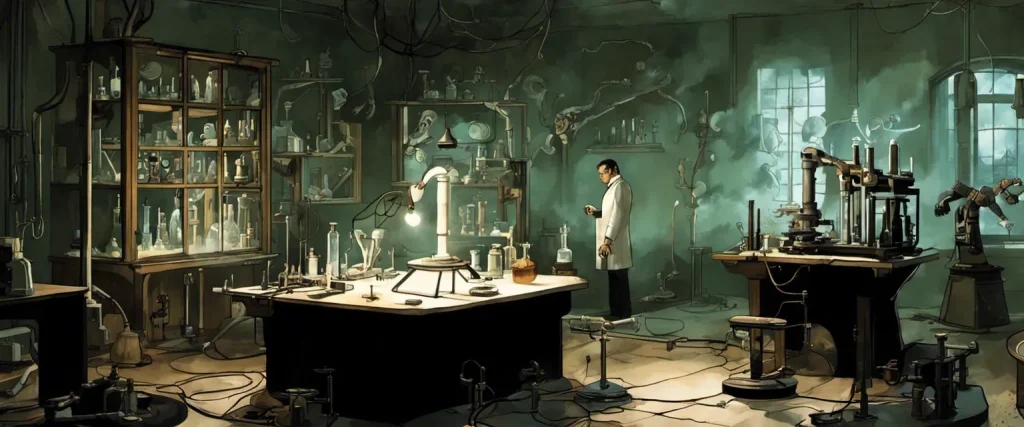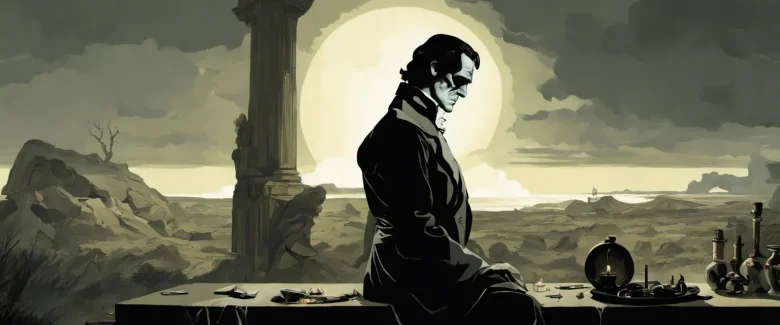In Mary Shelley’s iconic novel, Frankenstein, an ambitious and curious young scientist named Victor Frankenstein embarks on a treacherous journey of scientific exploration which ultimately leads to his creation of a living, breathing monster. Published in 1818, Shelley’s timeless masterpiece delves into the profound themes of creation, ambition, and the consequences of unchecked scientific progress. As the daughter of notable writers Mary Wollstonecraft and William Godwin, Mary Shelley’s own intellectual curiosity and tumultuous personal experiences greatly influenced her work, elevating her into a prominent figure of the Gothic literary tradition.
Chapter 1: Introduction and Background
Chapter 1 of Mary Shelley’s Frankenstein serves as an introduction to the story and provides essential background information. The novel begins with a series of letters written by Captain Robert Walton to his sister, Margaret. Walton is on an exploratory ship bound for the Arctic, and through his letters, he expresses his desire for companionship and ambition to accomplish great scientific achievements.
Walton describes his encounters with a stranger he rescued from the harsh Arctic weather, Victor Frankenstein, who soon becomes the main narrator of the story. Frankenstein recounts his early life, explaining that he grew up in Geneva, Switzerland, with his loving family. He had an insatiable curiosity and a desire for knowledge from a young age.
Frankenstein tells of his studies in natural philosophy, chemistry, and eventually alchemy. He becomes fascinated with the theories of the ancient alchemists and believes he can discover the secret of life. He becomes consumed by his experiments and isolates himself from his family and friends. Finally, Frankenstein achieves his goal and manages to create life in the form of a grotesque creature.
However, upon seeing his creation come to life, Frankenstein is filled with horror and disgust. He abandons the creature and hopes to forget the whole incident. The chapter concludes with Frankenstein’s warning to Walton about the dangers of pursuing knowledge without considering moral and ethical consequences.
Overall, Chapter 1 sets the stage for the novel by introducing the themes of ambition, scientific curiosity, and the moral responsibilities associated with the acquisition of knowledge. It also foreshadows the horror and consequences that Victor Frankenstein will face as a result of his reckless pursuit of scientific achievement.
Chapter 2: Creation of the Monster
In Chapter 2 of Mary Shelley’s Frankenstein, the focus shifts to Victor Frankenstein’s childhood and adolescence, his scientific interests, and his eventual journey to the University of Ingolstadt. The chapter primarily serves to contextualize Victor’s later creation of the monster.
As a child, Victor is fascinated by various scientific theories and ideas, eventually becoming engrossed in the works of alchemist Cornelius Agrippa. However, his father dismisses these studies as mere fantasies, urging him instead to pursue a more practical and traditional education. Despite this, Victor remains determined to delve into the mysteries of life and death.
Once at Ingolstadt, Victor throws himself into his studies, tirelessly exploring the realms of chemistry, anatomy, and natural philosophy. One particular theory that captures his attention is the idea of reanimating lifeless matter. This obsession intensifies after his beloved mother dies, leaving him grief-stricken and desperate to conquer death.
Victor becomes so engrossed in his experiments that he isolates himself from friends and family. He neglects his studies in other subjects and focuses solely on his quest to create life. After months of tireless dedication, Victor finally achieves his goal and brings his creature to life.
However, rather than celebrating his success, Victor is horrified by the physical appearance of his creation. He is repulsed by the monster’s yellow eyes, shriveled skin, and grotesque proportions. Overwhelmed by guilt and fear, Victor flees from the room, unable to bear the sight of what he has created.
In this pivotal chapter, Shelley skillfully presents the complexity of Victor’s character and the lingering consequences of his scientific ambition. As the stage is set for the monster’s entry into the narrative, a sense of foreboding and unease starts to take hold.
Chapter 3: The Monster’s Loneliness
Chapter 3 of Frankenstein, titled “The Monster’s Loneliness,” details the monster’s experiences immediately following his creation. Dr. Victor Frankenstein, the creator, abandons the creature out of fear and disgust. The monster is left to navigate the world alone, unaware of his own monstrous appearance and desperate for human interaction.
Initially, the creature wanders through the forest, where he experiences sensory overload. He is fascinated by the beauty of nature and its sounds, reassured that he is part of this world. However, when he stumbles upon a cottage, he encounters the De Lacey family. He observes them from a distance, captivated by their interactions and kind gestures towards one another.
Driven by his longing for companionship, the monster approaches the blind father of the De Lacey family, hoping for acceptance. However, his appearance terrifies and repulses the old man. The creature is devastated and retreats into solitude once again.
As the monster reflects on his experiences, he becomes increasingly aware of his isolation and the deep loneliness he feels. He realizes he is an outcast, rejected by humans due to his grotesque appearance. The rejection plunges him into despair and anger towards his creator, Victor Frankenstein, for his abandonment.
The monster’s loneliness and yearning for connection become a driving force throughout the rest of the novel. His experiences serve to highlight the theme of isolation and the consequences of unchecked ambition. Chapter 3 portrays the monster as a sympathetic figure, rejected solely due to his external appearance, laying the foundation for the subsequent tragedies that unfold in the story.
Chapter 4: The De Lacey Family
In Chapter 4 of Mary Shelley’s novel Frankenstein, the story takes a detour as the narrative shifts towards the De Lacey family. This family consists of Agatha, Felix, and their blind father, who live a simple and peaceful life in a cottage in the woods.
When the creature created by Victor Frankenstein stumbles upon the De Laceys’ cottage, it becomes infatuated with their peaceful way of life, longing for human connection and compassion. The creature takes advantage of the family’s blind patriarch and gains his trust by stealthily doing chores around the cottage, such as bringing them firewood and clearing the snow from their path.
During the creature’s observations of the De Laceys, it becomes fond of them, feeling deeply empathetic towards their suffering; Felix is a political exile unjustly separated from his love and Agatha strives to support her family with unwavering devotion. Though invisible to them, the creature frequently listens to their conversations and learns to understand their language by studying their interactions with one another.
Driven by a desperate need for companionship, the creature eventually decides to reveal itself to them, hoping to find solace and acceptance within their circle. However, when it first encounters the sight of its monstrous visage, the De Lacey family reacts with abhorrence and flees the cottage in terror, consequently leaving the creature heartbroken and desolate.
Chapter 4 serves as a pivotal moment in the novel as it explores the theme of acceptance and the dire consequences of prejudice. Additionally, it highlights the creature’s longing for love and connection, foreshadowing the tragic consequences that will unfold in subsequent chapters.

Chapter 5: Revenge and Tragedy
Chapter 5 of Frankenstein by Mary Shelley is titled “Revenge and Tragedy.” In this chapter, the consequences of Victor Frankenstein bringing his creature to life are revealed.
The chapter begins with Victor’s thoughts on the night he brings the creature to life. He narrates his overwhelming emotions – from excitement to disgust as he looks at his creation. The creature, however, is far from what Victor had envisioned, with a horrifying appearance. Disgusted and terrified, Victor quickly leaves the room and tries to regain his composure.
Overwhelmed with regret and fear, Victor decides to spend the night in his bedchamber. He is haunted by nightmares and anxiety, which lead him to contemplate the possible repercussions of his actions. Victor’s fear turns into a deep desire for revenge against his creation.
Victor receives a letter from his dear friend Henry Clerval, who is returning to Ingolstadt to see him. The arrival of Henry brings temporary relief to Victor’s tormented state of mind. Victor confides in Henry about the creation of the creature and reveals his intentions to destroy it.
The chapter takes a dark and tragic turn when Victor receives news that his youngest brother, William, has been murdered. Victor suspects that the creature is responsible for the crime. Consumed by grief and anger, Victor takes an evening journey to the woods presumed to be the scene of the murder.
During his journey, Victor encounters the creature and confronts him. The creature, however, denies the accusation and tells Victor his story, expressing his longing for companionship and acceptance. Despite the creature’s plea, Victor continues to hold a deep hatred towards him.
Chapter 5 concludes with the revelation of Victor’s identification of the creature as the murderer, leading to a deep sense of guilt and responsibility for the tragedy that has unfolded. The themes of revenge and tragedy are central in this chapter, setting the stage for the rest of the novel.
Chapter 6: Pursuit and Confession
Chapter 6 of Mary Shelley’s novel Frankenstein, entitled “Pursuit and Confession,” begins with Victor Frankenstein’s return to Geneva after two years of studying in Ingolstadt, Germany. Victor is filled with a sense of dread and anticipation as he nears home, haunted by the terrible secret he has been keeping to himself. Upon his arrival, he finds his younger brother, William, has been murdered.
Devastated by the loss, Victor confides in his father, revealing the truth about the creation of the monster and his fear that the creature might be responsible for William’s death. Victor feels a tremendous guilt and responsibility for the events that have unfolded, blaming himself for William’s tragic fate. He resolves to devote his life to seeking vengeance on the monster he has brought to life.
Victor’s resolve is further strengthened when he spots the monster lurking near the spot where William was found dead. Consumed by a mixture of fear and anger, Victor chases the creature through the mountains. Despite his efforts, he fails to capture the monster, eventually collapsing from exhaustion and despair.
As Victor recuperates in the mountain pass, he encounters his childhood friend, Henry Clerval, who has been worried about Victor’s recent behavior and had followed him from Ingolstadt. Henry’s arrival brings a temporary respite from Victor’s anguish, as they spend time together and victor tries to forget about the monster. However, this relief is short-lived, as Victor’s determination to confront his creation grows stronger each day.
Mary Shelley uses Chapter 6 to delve into the depths of Victor’s emotional turmoil and his inner conflict between his thirst for revenge and his remorse over creating such a monstrous being. The pursuit of the monster and Victor’s eventual confession to his father lay the groundwork for the tragic events that will unfold throughout the remainder of the novel.
Chapter 7: The Monster’s Demands
In Chapter 7 of Frankenstein by Mary Shelley, Victor Frankenstein receives a letter from his father urging him to return home to Geneva. However, Victor is burdened with guilt and refuses to leave his laboratory until his experiment is complete. Meanwhile, Justine, a servant in the Frankenstein household, is accused of murdering William, Victor’s youngest brother. Victor is devastated by the news and fears that the creature he created is responsible for the crime.
Once Victor arrives in Geneva, he finds his family in anguish over the loss of William. He is tormented by guilt, feeling that his creation is responsible for the murder. Consumed by his guilt and curiosity, Victor decides to climb a nearby mountain to clear his mind. He reaches the summit and, while contemplating his creation, he suddenly encounters the monster in person.
The creature recounts his experiences since his creation, expressing his desire for companionship and understanding. He demands that Victor create a female companion for him, promising that they will disappear forever and live in seclusion. The monster argues that his monstrous actions have been a result of his loneliness and isolation. Initially shocked and horrified, Victor eventually sympathizes with the monster’s plea and agrees to fulfill his request, hoping that it will prevent further harm.
Victor returns to his family home with a newfound determination to create the monster’s companion. However, as he begins his work, doubts and fears overwhelm him. He worries about the potential consequences of creating another creature as destructive as the one he already made. Victor’s moral conflict intensifies, forcing him to question the limits of scientific discovery and the consequences of playing god.
In this chapter, Shelley explores the theme of responsibility and the consequences of human ambition. Victor faces the weight of his actions and the moral dilemma of whether to create another monster in order to appease the creature he already made.

Chapter 8: Final Confrontation and Resolution
Chapter 8 of “Frankenstein” by Mary Shelley is the final confrontation and resolution of the novel. The chapter begins with Victor Frankenstein, the protagonist and creator of the monster, on a ship exploring the northernmost regions of the world. He is determined to destroy the monster he brought to life due to the devastation it has caused.
Victor and his crew navigate through treacherous ice until they encounter the creature. The monster, aware of Victor’s intention, boards the ship and pleads with his creator for Victor to listen to his story. Victor reluctantly agrees, and the monster recounts his miserable existence since his creation.
The monster explains that he was rejected by society and experienced extreme loneliness and isolation. Driven by despair, he sought revenge against his creator, causing destruction and death in his path. However, he expresses remorse for his actions and begs Victor for forgiveness.
Despite initially considering the monster’s plea, Victor ultimately decides to stand firm and carries out his plan to destroy the creature. However, as he attempts to murder the monster, the ship becomes stuck in ice, leaving him helpless. The monster delivers a chilling threat to Victor, promising to be with him on his wedding night, before disappearing.
Victor’s ship is rescued, and he returns to land, only to face another tragedy. Discovering that his beloved best friend, Henry Clerval, has been murdered, Victor immediately associates the crime with the monster. Overwhelmed with guilt and grief, he falls ill and remains bedridden.
Chapter 8 concludes with Victor recovering from his illness, and his father arrives to take care of him. Victor is determined to fulfill his promise to destroy the monster or die in the process, as he believes he is responsible for all the suffering caused by his creation.
After Reading
In conclusion, Mary Shelley’s Frankenstein is a profoundly thought-provoking novel that explores the perils of ambition, the nature of humanity, and the consequences of unchecked scientific advancement. With its captivating narrative and complex characters, the book demonstrates the destructive power of playing god and serves as a cautionary tale about the potential dangers of man’s desire to surpass nature. As the story unfolds, it becomes evident that the true monster lies not in the creature stitched together from various body parts, but in the flawed and morally corrupt scientist, Victor Frankenstein. Through this gripping tale, Shelley prompts readers to reflect upon the ethics of creation and the responsibility that comes with wielding such power, reinforcing the timeless idea that true progress must always be tempered with wisdom and compassion.
1. Fahrenheit 451″ by Ray Bradbury
In a world where books are banned and burned, Fahrenheit 451 explores the dangers of censorship and the power of literature. Bradbury’s dystopian novel offers a chilling and thought-provoking perspective on the dangers of government control and the importance of preserving knowledge and individual thought.
2. Guns, Germs, and Steel” by Jared Diamond
Drawing from a broad range of disciplines including anthropology, geography, and history, Jared Diamond’s groundbreaking work delves into the factors that determine the success and dominance of certain countries over others. Exploring the role of geography, agriculture, and technology, Diamond provides a fascinating analysis of why societies have developed differently throughout history.
3. Sapiens: A Brief History of Humankind” by Yuval Noah Harari
Following the completion of “Frankenstein,” immerse yourself in Harari’s captivating exploration of the history of Homo sapiens. From the emergence of our species to the present day, “Sapiens” offers a comprehensive view of how humans have shaped the world, from agricultural revolutions to scientific discoveries, while also addressing the ethical and societal implications of these advancements.
4. Brave New World” by Aldous Huxley
Similar to “Fahrenheit 451,” “Brave New World” presents a dystopian vision of the future. Set in a highly regulated society where pleasure and conformity are prioritized, Huxley’s novel challenges the reader to examine the complex relationship between individuality, technology, and societal control. This thought-provoking exploration of human nature and the consequences of a highly engineered society offers profound insights.
5. The Picture of Dorian Gray” by Oscar Wilde
In this classic Gothic novel, Wilde explores the corrupting influence of vanity, beauty, and moral degradation. After immersing yourself in Mary Shelley’s exploration of the pursuit of knowledge and its consequences, “The Picture of Dorian Gray” delves into the dark depths of human desires and the price one may pay for eternal youth and beauty. Wilde’s sharp wit and critique of Victorian society make this a timeless and compelling read.



